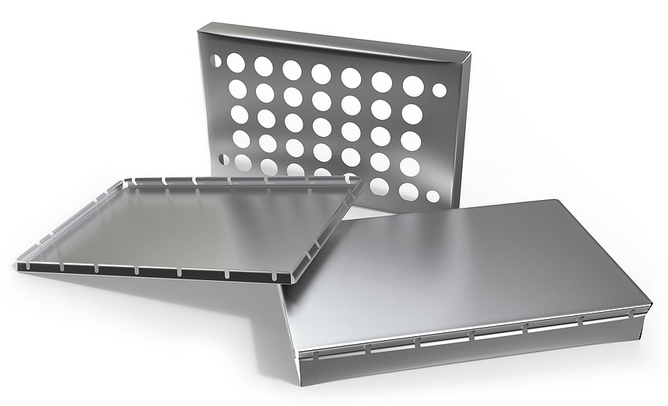EMI shielding is the use of specialized materials to protect sensitive electronics from electromagnetic interference (EMI). It’s also known as RF shields in some industries where radio frequencies (RF) are of particular concern.
This kind of interference can ruin measurements, add noise to signals, or even damage some types of equipment.
How Does EMI Shielding Work?
EMI shielding is a modern implementation of the principles behind a Faraday Cage. A Faraday Cage is a metal mesh or grid that intercepts and dissipates electromagnetic radiation.
They can vary widely in size and applications, with the metal mesh visible in a microwave oven’s window being a prime example. The protection provided by a Faraday cage works in both directions, stopping electromagnetic waves from entering or exiting.
Today, EMI shielding comes in many forms that have been carefully developed for their unique applications. It doesn’t require a large metal cage but can instead be anything from wiring to conductive paint.
These solutions are designed with the level of protection they need to provide, the specific frequencies they need to stop, and other application-specific criteria in mind.

EMI Shielding in Industry
With the increasing use of electronics has come the need for more RF shields than ever before. Many devices have become exceedingly sensitive, whether intentionally in the case of scanning equipment or inadvertently through the miniaturization of electronics.
This means there are more unique cases that require effective EMI shielding, each with its own purpose and challenges.
EMI Shielding in Aviation
Airplanes rely on a wide range of electronics to fly safely, and any interference with these electronics could be disastrous. While the metal body of the aircraft itself provides natural EMI shielding from many sources of outside interference, there is still interference from within the plan to worry about.
This can come from the electronic devices that passengers bring on board or from other plane systems.
Most aircraft rely on antennas for a wide range of critical functions. This includes communications with air traffic control and automated collision-avoidance systems, weather radar, landing systems, and more. EMI could lead to issues with these signals, so there are multiple protective measures put in place on aircraft.
Aircraft incorporate both single and double-shielded cables. These are cables that contain layers of EMI protection to prevent signal interference. They also use EMI shielding gaskets that serve to isolate electronic enclosures at the points where cables enter and exit.
EMI Shielding in Medicine
With the advent of MRI and other advanced scanning and imaging techniques, medicine has rapidly become an industry that is highly dependent on effective EMI shielding.
These devices are incredibly sensitive. They have to be in order to generate the high-detail scans that are so vital to modern medicine. That sensitivity leaves them open to the possibility of even minor EMI causing issues.
The rooms that house these devices are themselves prepared with EMI shielding. Walls, ceilings, and doors all incorporate EMI shielding material.
When the hospital’s electrical wiring passes near these rooms, it must be passed through specialized shielding conduits. The entire room itself will have continuous metal foil behind its walls.
Beyond the construction of the room, other electronics inside the room must have EMI shielding in place to prevent interference as well. This includes many of the MRI machine’s own components, with internal shielding being incorporated. These medical applications are among the most demanding for EMI shielding.
EMI Shielding in Telecommunications
Telecommunications today relies on a wide range of wireless signals, from the communication between your cell phone and the cell tower to the satellites that carry out communications globally. All of these devices are carefully designed to capture electromagnetic waves and convert them into electrical signals. The problem is that this can leave them vulnerable to unwanted interference.
While a cell tower might be intended to pick up the signal from your cell phone, it can also pick up other interference if it isn’t protected. This can degrade the quality of the information and even lead to damage if the interference is strong enough. EMI shielding makes it possible for these kinds of telecommunications equipment to target specific frequencies and avoid interference from others.
Consumer devices must similarly incorporate EMI shielding to be able to function properly. Phones and other devices can’t rely on plastic cases alone but also integrate conductive paint or other measures to provide EMI protection against certain frequencies.
EMI Shielding in Computing
Computers and related components contain sensitive electronics that are liable to become damaged due to EMI. Due to the small size of these elements, even relatively minor spikes in voltage induced by EMI can cause serious damage. Even if parts aren’t damaged, these events can still lead to data corruption.
For many computing applications, the power source itself is a significant source of EMI. Shielding is often required to prevent power sources from causing interference. This is a major problem in data centers in particular, where many computers are brought together into a compact space. This increases the risk of EMI and has led to novel ideas being implemented to solve the problem.
Most data centers make extensive use of shielded cabling. They use a variety of different shielding techniques for cabling that can provide protection against specific frequency ranges. Some applications take this protection further by incorporating ferrite cores around wiring that suppress outgoing interference.
This is on top of many standard protections that are placed around individual computers and servers. Coating plastic enclosures with conductive paint or copper foil is a common practice, and these facilities also implement EMI shielding gaskets to great effect.
The Future of EMI Shielding
The need for innovative applications of EMI shielding is still growing today. With more wireless technology in place year after year, the technologies and materials used to achieve effective RF shielding are evolving at a rapid pace.
Even with the wealth of EMI shielding options available today, the industry is continuously innovating and developing new solutions.